Selecting Our Meade LX200
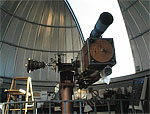 Take a look at at the cluster of telescopes which were our main stay for over a decade. There are three large telescopes. On the top was our most useful telescope, a lovely blue 7" Astro Physics StarFire refractor. The tale of the 7" StarFire continues in another essay you might find interesting. Just below the Starfire was our largest telescope, a 12" reflector built by a group from URI. Suspended from it, was a 4" Alvin Clarke & Son's 4" refractor on loan to us. At the back are several small spotting telescopes., The counterweights on the telescope's left side weighed almost a quarter ton and had to be moved carefully to avoid clonking someone on the head.
Take a look at at the cluster of telescopes which were our main stay for over a decade. There are three large telescopes. On the top was our most useful telescope, a lovely blue 7" Astro Physics StarFire refractor. The tale of the 7" StarFire continues in another essay you might find interesting. Just below the Starfire was our largest telescope, a 12" reflector built by a group from URI. Suspended from it, was a 4" Alvin Clarke & Son's 4" refractor on loan to us. At the back are several small spotting telescopes., The counterweights on the telescope's left side weighed almost a quarter ton and had to be moved carefully to avoid clonking someone on the head.
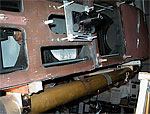 In the summer of 1998,
In the summer of 1998,  ten years of alternating heat and cold finally separated the secondary [diagonal] mirror of our 12 inch reflector from its mount. The secondary mirrors fell onto the primary mirror, damaging both severely. On the right you can see the side of the old 12" with its JMI automated focuser. This placement for the eyepiece meant that usually only cameras could be used with the 12" because the eyepiece often moved to inaccessible place such as 2/3 of the way to the top of the dome as we moved the telescope. The telescope below the 12" is an hierloom Alvin Clarke and Son telescope which is more than 135 years old. It was loaned to us and has been returned. On the left, you can see the remains of the mount and part of the primary mirror. What doesn't show is the chunk gouged from the primary.
ten years of alternating heat and cold finally separated the secondary [diagonal] mirror of our 12 inch reflector from its mount. The secondary mirrors fell onto the primary mirror, damaging both severely. On the right you can see the side of the old 12" with its JMI automated focuser. This placement for the eyepiece meant that usually only cameras could be used with the 12" because the eyepiece often moved to inaccessible place such as 2/3 of the way to the top of the dome as we moved the telescope. The telescope below the 12" is an hierloom Alvin Clarke and Son telescope which is more than 135 years old. It was loaned to us and has been returned. On the left, you can see the remains of the mount and part of the primary mirror. What doesn't show is the chunk gouged from the primary.
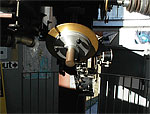
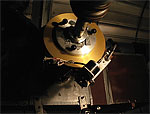 What appeared to be a disaster became through an odd but wonderful set of circumstances a major stroke of luck. Even if restored, our telescope luster was driven a cranky and idiosyncratic home made clock drive. The gears and motors on the left are what we used to track the sky for almost a decade. Everything was exposed. No covers were removed for this shot. Only the extremely slow movement of the gears prevented problems. Notice the C-clamps used to align the gears! The drive motor at the bottom required frequent repair. The smaller motor at the right side of this image was intended slews (positions electrically) the telescope cluster left and right. For all practical purposes this slewing motor was a complete failure - all telescope targeting had to be done by hand. In the left hand image we can see the another small motor which failed at its function as an up/down slewing device, but at least acted as a clamp to keep the big gear from spinning. [Of course, a 79 cent c-clamp would also have worked].
What appeared to be a disaster became through an odd but wonderful set of circumstances a major stroke of luck. Even if restored, our telescope luster was driven a cranky and idiosyncratic home made clock drive. The gears and motors on the left are what we used to track the sky for almost a decade. Everything was exposed. No covers were removed for this shot. Only the extremely slow movement of the gears prevented problems. Notice the C-clamps used to align the gears! The drive motor at the bottom required frequent repair. The smaller motor at the right side of this image was intended slews (positions electrically) the telescope cluster left and right. For all practical purposes this slewing motor was a complete failure - all telescope targeting had to be done by hand. In the left hand image we can see the another small motor which failed at its function as an up/down slewing device, but at least acted as a clamp to keep the big gear from spinning. [Of course, a 79 cent c-clamp would also have worked].
About this time, we received a grant of $5000 from the Beveridge Foundation located in Florida. Initially we planned to use this to restore the existing cluster and to replace the clock drive with something more up to date. The equipment in the dome while large could not compete in sophistication with GOTO telescopes set up outside almost every week. As we investigated the possibilities, we began to convince ourselves that a restoration wasn't in our best interest. We determined that we could replace the cluster with a far better system if we could raise four to five times the amount of the initial grant.
We had a number of objectives which we intended to satisfy:
- The eyepiece had to be easy for people to reach.
- More people needed to see more celestial objects in less time.
- Ladders had to be replaced by a stable platform.
- The system needed to be adaptible and extendable.
- The equipment needed to be containable in our dome.
- We wished to generate added public interest and awareness of FDO.
- Advanced astronomical techniques (CCD, photography and remote operations) were desirable but not critical.
- We needed a system which could be run by our existing staff and yet was sophisticated enough that it would draw additional astronomers to our facility.
- The entire plan had to be financially feasible.
We contacted and visited various universities and other sites with telescopes in the 12-20 inch range. We were treated exceptionally well by these institutions. They allowed us to everything from talking about their own public outreach programs to allowing us to climb, peer, poke and prode their equipment. We made an intensive study of advertisements, Internet web sites, and corporate literature. We looked at specifications and options until we could barely keep them straight.
Three telescopes began to emerge as the best alternatives. Two of the entries were by the Meade Corporation and the third by the Celestron Corporation. Superb instruments were also available from some half dozen additional corporations but were excluded one reason or another. In some cases, the cost was excessively high for a sea level system. A recent telescope installed in Connecticut only slightly larger than ours cost millions. Newtonian telescopes have eyepieces which wander into positions that can only be reached from very tall ladders. We already owned a large refractor, but the cost of equiping it with electronics and slewing features were substantialy as great as a whole new system and we wouldn't be sure if it would work ahead of time. We dared not go the route of asking for a fully customized design for a new telescope. Flaws in custom telescopes must be corrected by the new owners rather than the manufacturers.
We determined that a Meade LX200 16" was the best of the avaiable systems, with a Celestron 14" and a Meade 12" as fall back systems if we couldn't obtain the extra money. We expected to mount a two or three year campaign to collect the additional money but the Frosty Drew Fund's rainy day reserves had grown large enough over the previous decade to allow us to immediately begin the process of purchasing a telescope. We were given wonderful latitude in selecting both the telescope and its supporting accessories.
 A Meade 16" LX200 is not a custom design. We had no input into the design of the optics or the electronics. However, in one area, mating the Meade telescope to our existing pedestal and pier, we were required to make a number of design changes. We used a Computer Aided Design [CAD] program to match the Meade telescope with our existing pier and pedestal. The two most significant changes were the cutting of a ten inch circular hole in the Meade pier, and the decision to use an altiazimuth rather than the existing equitorial mount. The hole in the pier allowed us to slide the Meade pier over our existing 8.75 inch pier and pedestal. After repeated calls and e-mail diagrams both FDO and Meade were satified. The end result matched perfectly.
A Meade 16" LX200 is not a custom design. We had no input into the design of the optics or the electronics. However, in one area, mating the Meade telescope to our existing pedestal and pier, we were required to make a number of design changes. We used a Computer Aided Design [CAD] program to match the Meade telescope with our existing pier and pedestal. The two most significant changes were the cutting of a ten inch circular hole in the Meade pier, and the decision to use an altiazimuth rather than the existing equitorial mount. The hole in the pier allowed us to slide the Meade pier over our existing 8.75 inch pier and pedestal. After repeated calls and e-mail diagrams both FDO and Meade were satified. The end result matched perfectly.
In the prior photograph, you can also see the second result of our CAD design work. This is our rotating platform which allows us to avoid the use of ladders in a darkened dome. We expected it to be very useful with families and anyone who found a ladder daunting. What we did not exepect to find, was that it was a major help installing the new telescope. We installed a shelf at the end of the platform which now holds our collection of optical accessories.

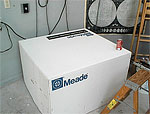 Once the order was placed in early March, we held our breath. We had cut it rather close for Meade's once or twice a year manufacturing run of large telescopes. Most of the year, their facilities are fully occupied with their bread and butter smaller off the shelf systems. We made the cut off and by late June we were expecting a delivery truck with crates of mysterious pieces. Sure enough on the appointed day, an ABF truck arrived with lots of strange boxes and parts. And oh yes, and a can of cold fizzies.
Once the order was placed in early March, we held our breath. We had cut it rather close for Meade's once or twice a year manufacturing run of large telescopes. Most of the year, their facilities are fully occupied with their bread and butter smaller off the shelf systems. We made the cut off and by late June we were expecting a delivery truck with crates of mysterious pieces. Sure enough on the appointed day, an ABF truck arrived with lots of strange boxes and parts. And oh yes, and a can of cold fizzies.
We weren't idle by any means. Over and over we studied documentation, practiced with software simulations and wrote instruction manuals. The biggest part of the effort was the detailed planning that allowed us to keep the existing telescope operational until a two week window when we replaced the old with the new.

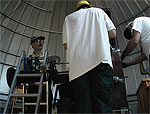 Removing the old telescope was no easy job. We had nearly 500 pounds of lead and steel in the counterweights alone. On the left Les carefully caps the StarFire which was still in excellent conditions and had to be saved. On the right, you can see our crew unbolting the remains of the old damaged 12" Newtonian from the supporting wedge and pier. You can see the metal ladder that was used to hold the unsupported weight of the unbalanced scope. Many of the parts and pieces had to be salvaged. Some were returned to their owners. Other valuable pieces were later resold. We couldn't just whale away with crowbars and heavy hammers.
Removing the old telescope was no easy job. We had nearly 500 pounds of lead and steel in the counterweights alone. On the left Les carefully caps the StarFire which was still in excellent conditions and had to be saved. On the right, you can see our crew unbolting the remains of the old damaged 12" Newtonian from the supporting wedge and pier. You can see the metal ladder that was used to hold the unsupported weight of the unbalanced scope. Many of the parts and pieces had to be salvaged. Some were returned to their owners. Other valuable pieces were later resold. We couldn't just whale away with crowbars and heavy hammers.
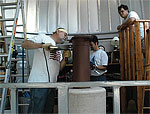
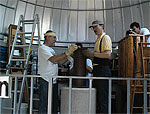 Once everything had been removed we got to the worst part of the job. The old pier had a 5/8ths steel mounting plate on the top. We could not cut it with a welding torch because the pipe had been packed with architect's sand to deaden vibrations. Cutting into a pipe filled with sand by a torch has lead to explosions at other locations. This left us with the arduous task of cutting through the pipe with electric saws. Hours of work by teams of two people and many blades later we had sucess. In the left hand photo, you can see Chuck cutting while Joe is replacing a damaged blade with a new blade. On the right, you can see the tricky last cut being made while Chuck and Dave keep the plate from binding the saw.
Once everything had been removed we got to the worst part of the job. The old pier had a 5/8ths steel mounting plate on the top. We could not cut it with a welding torch because the pipe had been packed with architect's sand to deaden vibrations. Cutting into a pipe filled with sand by a torch has lead to explosions at other locations. This left us with the arduous task of cutting through the pipe with electric saws. Hours of work by teams of two people and many blades later we had sucess. In the left hand photo, you can see Chuck cutting while Joe is replacing a damaged blade with a new blade. On the right, you can see the tricky last cut being made while Chuck and Dave keep the plate from binding the saw.
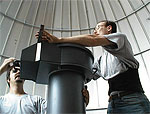
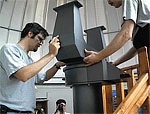 As you have seen above, the base slid perfectly over the old pier. On the right, Dave and Joe mounted the base (which contains the azimuth drive, control panel and the on-board computer) on the base pedestal. In spite of everything fitting well, care had to be taken not to jar anything violently or cross thread premounted bolts. On the right, Dave and Joe have taken the next step and mounted the yoke which hold the scope proper and contains the altitude drive. You can see Joe concentrating on getting the alignment perfect.
As you have seen above, the base slid perfectly over the old pier. On the right, Dave and Joe mounted the base (which contains the azimuth drive, control panel and the on-board computer) on the base pedestal. In spite of everything fitting well, care had to be taken not to jar anything violently or cross thread premounted bolts. On the right, Dave and Joe have taken the next step and mounted the yoke which hold the scope proper and contains the altitude drive. You can see Joe concentrating on getting the alignment perfect.
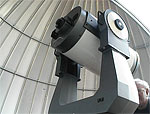 The instructions state that the Optical Tube Assemble can be field mounted by two people in the dark. The idea that any two normal people can gently maneuver a slick surfaced 175 pound cylinder containing extremely fragile mirrors and lenses nine feet above a floor onto a yoke which looks like a vice grip built for King Kong boggles the mind. Yeah - sure - right. I wouldn't try this with fewer than four husky guys and full daylight. That is of course unless one of you is Clark Kent and the other is the Hulk. Those two guys are easily strong enough and in any case who needs light if one of you has X-ray vision and can fly?
The instructions state that the Optical Tube Assemble can be field mounted by two people in the dark. The idea that any two normal people can gently maneuver a slick surfaced 175 pound cylinder containing extremely fragile mirrors and lenses nine feet above a floor onto a yoke which looks like a vice grip built for King Kong boggles the mind. Yeah - sure - right. I wouldn't try this with fewer than four husky guys and full daylight. That is of course unless one of you is Clark Kent and the other is the Hulk. Those two guys are easily strong enough and in any case who needs light if one of you has X-ray vision and can fly?
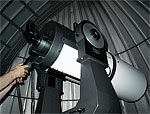
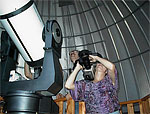 By now we had something that looked like it might actually work. The basic controls actually worked! The telescope did just what we asked it to do! Lots of bells and whistles have yet to be attached, but it looks enough like a real instrument that our local cable channel taped the scope as it moved towards the shutter opening. Looks like we have a go for launch. We pointed to the first likely item in the daytime sky and got ready to see if the thing actually worked.
By now we had something that looked like it might actually work. The basic controls actually worked! The telescope did just what we asked it to do! Lots of bells and whistles have yet to be attached, but it looks enough like a real instrument that our local cable channel taped the scope as it moved towards the shutter opening. Looks like we have a go for launch. We pointed to the first likely item in the daytime sky and got ready to see if the thing actually worked.
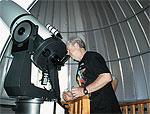 Les was selected to get the very first chance to look through the telescope. Only the Sun and Moon can be easily seen in the daytime. The Sun pours a blast of light and heat (several thousand degree's worth) through the telescope into the eye of the beholder. Since wisdom is the better part of valor, and since Les figured his eyes could probably be useful in the future, he chose the Moon as our first target.
Les was selected to get the very first chance to look through the telescope. Only the Sun and Moon can be easily seen in the daytime. The Sun pours a blast of light and heat (several thousand degree's worth) through the telescope into the eye of the beholder. Since wisdom is the better part of valor, and since Les figured his eyes could probably be useful in the future, he chose the Moon as our first target.
We inaugurated our new telescope with a First Light Party - the traditional get together that launches a new telescope. On July 30th, we invited everyone to come to our party and to stay for an evening of viewing. The Drew family including Frosty Drew's mother, brother and sister came in from various states and localities. I was touched when Frosty's mother presented me with a copy of a children's book he had written. I will some day give it to my granddaughter when she is old enough to appreciate what it means.
Join us now as Liisa Hartley feeds us cookies and punch. Maybe we can listen in as the Officers of the Frosty Drew Memorial Fund hold an impromptu session. Maybe we can join Art and Rob as they set up additional telescopes in the yard. Better yet, why don't we watch as kids, moms and dads look at planets, ask questions and do exactly what Frosty Drew Observatory is designed to do - make learning about the sky an enjoyable adventure.
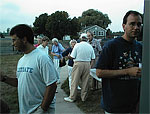
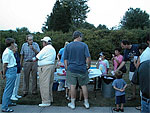


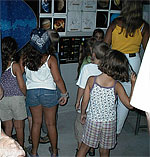
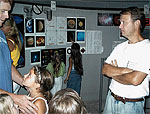
Finally, after the cookies and punch were gone and the kids had a chance to see pictures of planets, the sky got dark enough for us to let people in. The line was long (too long for comfort), but with a little hamming it up from Les as he talked about the night sky and a lot of patience from our Party goers, the line moved forward.

So how did we do? Pretty well, I'd say. We never got a chance to see if any of our backup plans worked. Beyond all expectations, Plan A worked every time. Everything fit, everything worked and with the exception of one minor part sent to us for a smaller telescope (quickly rectified), everything was what we wanted.
(1) The MeadeLX200 Schmidt/Cassegrain telescope design with its eyepiece in the back and compact barrel makes the eyepiece accessible at all elevations with no more than an 18" foot stool.
(2) Finding a new target only takes seconds with the GOTO functions built into the telescope. Dim objects could take as much as ten or fifteen minutes to find before. The platform allows whole families to be at the telescope at a single time. Computers allow us to plan and point the telescope in minutes. Looking up coordionates is instantaneous rather than a search through documents. All in all, we can provide far more viewing time of far more objects each Friday night. We find we dare try for obscure (but interesting) tragets that would have been a waste of the public's time and attention before.
(3) Ladders are replaced by a stable rotating platform. This platform has also proved to be ideal for keeping eyepieces, filters and other optical accessories at hand rather than making cumbersome trips back and forth to a locker in the dark. Since whole families, the astronomer and the viewer can all be at the telescope together, many children are able to see things which they would have missed on a trip up a ladder.
(4) The system is adaptible and extendable. Unlike our prior system which had no available accessories except for eyepieces or by adapting or retrofitting accessories meant for another telescope, the Meade LX200 line has the greatest number of available accessories of any large telescope. We are fortunate to have been able to purchase many of them.
(5) The Meade LX200 easily fits inside our dome. With the required base modifications, it meshes perfectly with our existing pier. Unlike a Newtonian of the same focal length, the compact Schmidt design keeps the tube small enough to fit our dome. (A similiar focal length Newtonian would actually either sweep everyone around in the dome or would have to stict through the shutter).
(6) We have generated added interest. Our Friday night crowds are bigger than ever and we are giving people more chances to see more things than ever.
(7) Advanced astronomical tools (CCD, photography and remote operations) have been included even though they were deemed only desirable not critical for an Observatory whose principle purpose is public education. We have to admit that some of the more sophisticated accessories are still a mystery to most of us, but we are learning fast.
(8) All of our existing staff have learned to run the new telescope. We have had a few astronomers join us since we installed the telescope. Notable among these is Allyson Polak, a graduate student in physics and astronomy, who hopes to make astronomy her career. In spite of our partial success in increasing our numbers, this is the single area where reality has not met expectations. We are actively looking for interested astronomers (and even those who are not yet astronomers) to join us as regulars.
(9) We are very thankful for major finacial help from two foundations, donated parts and labor by contractors, encouragement by the officers of the Frosty Drew Memorial Fund and lots of sweat equity by our members and staff. With careful attention to costs and advantageous sales of surplused equipment, we managed to install the telescope two and a half years ahead of our original schedule without shattering the piggy bank too badly. Not bad - not bad at all!
